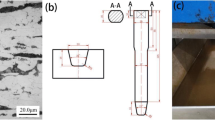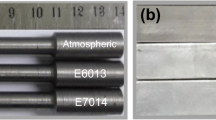Abstract
Friction stitch welding is a promising underwater solid-phase joining technology, and research on the process is important in both theory and engineering. Friction stitch welded joints obtained in underwater environments have high hardness, but poor mechanical properties. An underwater local dry chamber system was designed to avoid the disadvantage of fast cooling in wet conditions, which would assist in decreasing the hardness, and the microstructure and mechanical properties of friction stitch welds of DH36 steel in local dry conditions were investigated. The results showed that, when using LF2 steel as plug material and the welding parameters of 7000-rpm plug rotating speed, 35-kN axial force, 40-kN forging force, 14-mm burn-off distance of the plug, 8-s forging time, and a 25° tapered bore with a 19° tapered plug, excellent mechanical properties were obtained in the weld produced in a local dry chamber in an underwater environment. The microstructure presented metallurgical bonding at the sidewalls and joint bottoms. The maximum hardness of the weld was 381 HV10, and the average was 300 HV10, which were lower than those obtained in wet conditions. The maximum tensile strength of the weld was 500 MPa. Tensile fracture occurred at the base metal under the average impact energy of 45 J at 0 °C on the bonding interface.
Similar content being viewed by others
References
Pessoa ECP, Bracarense AQ, Santos VRD, Monteiro MDJ, Vieira MLA, Reppold MR (2012) Challenges to develop an underwater wet welding electrode for “Class A welds” classification, as required in the AWS 03.6 code. ASM Int Mater Park 259-267
Shi Y, Wang G (2006) Vision based seam tracking system for underwater flux cored arc welding. Sci Technol Weld Join 11(3):271–277
Hattingh DG, Wielligh LV, Thomas W, James MN (2015) Friction processing as an alternative joining technology for the nuclear industry. J S Afr I Min Metall 115(10):903–912
Chludzinski M, Paes MP, Bastian FL, Strohaecker TR (2012) Fracture toughness of friction hydro-pillar processing welding in C–Mn steel. Mater Des 33(1):340–344
Ambroziak A, Gul B (2007) Investigations of underwater FHPP for welding steel overlap joints. Arch Civ Mech Eng 7(2):67–76
Li K, Gao H, Li H, Gong S (2014) Droplet rebounded spatter in dry hyperbaric gas metal arc welding process. Int J Adv Manuf Technol 74(5–8):693–698
Zhang XD, Ashida E, Shono S, Matsuda F (2006) Effect of shielding conditions of local dry cavity on weld quality in underwater Nd : YAG laser welding. J Mater Process Technol 174(1–3):34–41
Zhang XD, Chen W, Ashida E, Matsuda F (2004) Relationship between weld quality and optical emissions in underwater Nd: YAG laser welding. Opt Lasers Eng 41(5):717–730
Jia C, Zhang T, Maksimov SY, Yuan X (2013) Spectroscopic analysis of the arc plasma of underwater wet flux-cored arc welding. J Mater Process Technol 213(8):1370–1377
Shi Y, Zheng Z, Huang J (2013) Sensitivity model for prediction of bead geometry in underwater wet flux cored arc welding. Trans Nonferrous Metals Soc China 23(7):1977–1984
Mcpherson NA, Galloway AM, Cater SR, Hambling SJ (2013) Friction stir welding of thin DH36 steel plate. Sci Technol Weld Join 18(18):441–450
Yin Y, Yang X, Cui L, Cao J, Xu W (2015) Microstructure and mechanical properties of underwater friction taper plug weld on X65 steel with carbon and stainless steel plugs. Sci Technol Weld Join 21(4):259–266
Hattingh DG, Bulbring DLH, Els-Botes A, James MN (2011) Process parameter influence on performance of friction taper stud welds in AISI 4140 steel. Mater Des 32(6):3421–3430
Perrett JC, Sketchley PPJC (2007) Hole repair in steel plate using friction taper plug welding - initial trials in air and underwater. TWI Report 864
Cui L, Yang XQ, Wang DP, Cao J (2016) Underwater friction taper plug welding process and mechanical properties of joints for DH36 steel. Trans China Weld Inst 37(06):75–79, 132 (in Chinese)
Zhang XD, Deng CY, Wang DP, Wang ZJ, Teng JH, Cao J, Xu W, Yang F (2016) Improving bonding quality of underwater friction stitch welds by selecting appropriate plug material and welding parameters and optimizing joint design. Mater Des 91:398–410
Jia WZ, Zhu JL, Gao H, Jiao XD, Zhou CF (2010) Study on the gas cup applied in underwater local dry welding. J Beijing Inst Petro-Chem Technol (04): 47-50 (in Chinese)
Cui L, Yang XQ, Wang DP, Hou X, Cao J, Xu W (2014) Friction taper plug welding for S355 steel in underwater wet conditions: welding performance, microstructures and mechanical properties. Mater Sci Eng A 611(31):15–28
Wang FX, Yang XQ, Yin YY, Cui L (2017) Thermal process influence on microstructure and mechanical behavior for friction taper plug welding in structural steel S355. Int J Adv Manuf Technol 88(9):3459–3466
Zhang X, Deng CY, Wang DP, Wang ZJ, Cao J, Song GX, Huang JZ (2017) Microstructures and mechanical properties of underwater friction stitch welding of DH36 steel. Accepted by Transactions of the China Welding Institution (in Chinese)
Author information
Authors and Affiliations
Corresponding author
Rights and permissions
About this article
Cite this article
Chen, S., Wang, D., Wang, Z. et al. Microstructure and mechanical properties of friction stitch welds of DH36 steel in local dry conditions. Int J Adv Manuf Technol 93, 3615–3624 (2017). https://doi.org/10.1007/s00170-017-0745-8
Received:
Accepted:
Published:
Issue Date:
DOI: https://doi.org/10.1007/s00170-017-0745-8




